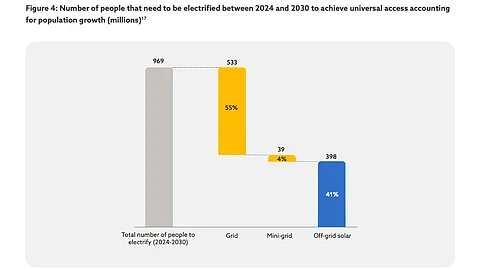

Off-grid solar can be the most cost-effective way to provide electricity access to 398 million people globally by 2030
Affordability remains a big factor in scaling up the use of off-grid solar, for which investments need to grow 6-fold
Authors of the report recommend a $21 billion investment and an additional $74 billion for addressable markets of solar water pumps, cold storage solutions, etc.
A new report by the World Bank’s Energy Sector Management Assistance Program (ESMAP) and Global Off-Grid Lighting Association (GOGLA) claims off-grid solar (OGS) is the most cost-effective way to power 41% of the world’s population living without any access to electricity, by 2030. This would translate to 398 million people out of 969 million that are still living without electricity.
The OGS sector served 561 million people in 2023, accounting for 55% of new connections in Sub-Saharan Africa from 2020-2022, according to the report Off-Grid Solar Market Trends Report (MTR) 2024.
The writers explain that OGS enables households, businesses, and farmers to use electricity productively, while also generating income and enhancing health and education outcomes as it electrifies schools, healthcare, facilities, and community centers.
In 2022 and 2023, more than 50 million OGS products were sold with a market turnover of $3.9 billion and $3.8 billion, respectively.
According to the report, Tier 1 electricity access refers to the initial level of access to electricity wherein households can charge their phones, lights, radios for a limited time each day. Tier 2 access is related to powering additional appliances and greater daily usage.
Of the 560 million who have secured electricity access through OGS, 253 million have gained Tier 1 access, while 132 million are benefiting from Tier 2 and enhanced access.
However, affordability is one key factor since only 22% of such households can afford the monthly payment required for a Tier 1 solar energy kit on a pay-as-you-go (PAYG) basis. Tier 2 products can only be afforded by 1%, and are affordable at a stretch for 2%.
Taking these products to conflict-affected or remote areas increased their prices locally by around 57%.
Despite the waves OGS has been making, 685 million were still living in energy poverty in 2022. At the current level of investments and trends, 660 million will still be living without tier-I electricity access at the end of this decade, according to the report writers.
To achieve the universal energy access target, investment in OGS must increase 6-fold over current levels to $21 billion, recommend the authors. Public funding of this volume can electrify 398 million people most cost-effectively.
Another $74 billion would be required to cover the addressable markets for solar water pumps, cold storage solutions, and Tier 2+ OGS solutions for micro, small and medium-sized enterprises (MSME). In comparison, in 2022-2023, investment into the OGS reached a high of $1.2 billion, largely driven by debt financing.
“The industry has shown tremendous resilience in challenging macroeconomic conditions,” said Executive Director at GOGLA Sarah Malm. “Companies, investors, governments, and development partners need to work together NOW to unlock the $21 billion needed to create a financially sustainable off-grid solar sector, that can scale, serve the hardest-to-reach and help achieve energy access and climate goals and ambitious initiatives like M300.”
M300 or Mission 300 initiative is a partnership between the World Bank Group and the African Development Bank (AfDB) to connect 300 million people to electricity across Africa by 2030.
The complete report is available on the ESMAP website for free download.
